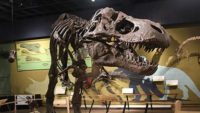A team of researchers used more than two million images obtained by NASA’s Lunar Reconnaissance Orbiter to construct the first near-global map of rockfalls on the moon. The map shows more than 136,000 rockfalls between 80° northern and southern latitudes on the lunar surface.1,2 Interestingly, the scientists—who were from ETH Zurich and the Max Planck Institute for Solar System Research—were surprised to find that… More… …read more Source: icr.org
An ancient city found deep in a Central American rainforest yields a surprising discovery. A recent BBC report earlier this month is revising assumptions about “Mosquito Coast” jungle biodiversity. The report covered ecoscience research conducted in tropical rainforests of Nicaragua and Honduras. Apparently some jungle creatures assumed to be regionally extinct—or even completely extinct—still survi… More… …read more Source: icr.org
Scientists from China, Sweden, and Australia have discovered what they claim is the oldest known parasite, publishing their results in Nature Communications.1 The evidence comes from small tube-shaped objects attached to the shells of the host brachiopods.2 Scientists speculate that these tubes contained some sort of parasitic worm. Parasites are “nutritionally dependent upon the host for at lea… More… …read more Source: icr.org
Under ideal circumstances, we can do a lot of good. But when circumstances handicap or restrict our potential—in ways we cannot circumvent—we just do the best that we can. That principle is true for humans as well as in the water-filtering services of the humble bivalves we call oysters—according to recent research involving the University of Maryland.1,2 Dr. Matthew Gray, an ecologist at… More… …read more Source: icr.org
In 2017, a large dinosaur was discovered washed out to sea,1 similar to the dinosaur bone found 70 miles off Norway’s coast.2 Only this one was partially intact, nearly perfectly preserved, and still contained its last meal fossilized inside its gut.1 Recently, a group led by paleontologists from the Royal Tyrrell Museum of Palaeontology examined the stomach contents of the dinosaur and reported their findin… More… …read more Source: icr.org
By Ken Ham If you were hunting for dinosaur footprints, it probably wouldn’t occur to you to look up—but that’s exactly where a team of researchers discovered a trackway of the footprints of a titanosaur (long-necked sauropod). In Southern France, researchers were crawling through a labyrinth of cave passages and discovered the prints, 1,640 feet underground. The researchers discovered 38 tracks, some of which were four feet long (now that’s one big dinosaur!), likely made by three of the giant creatures. The researchers discovered 38 tracks, some of which were four feet long (now that’s one big dinosaur!), likely made [More]
A recent attempt by European astronomers to use the Hubble Space Telescope to find evidence for the first stars expected by secular theory has failed. This is despite the Hubble Space Telescope’s ability to image objects at vast distances—so vast that these objects were supposedly formed 500 million years after the alleged Big Bang.1-3 Astronomers classify stars into three populations, or groups, according to… More… …read more Source: icr.org
The very first tapejarid pterosaur identified in the United Kingdom was recently found on the Isle of Wight along the southern coast of England.1 But the discovery also raises some questions that are uncomfortable for uniformitarian scientists. Tapejarids are extinct flying reptiles that have “elaborate soft tissue head crests” and a few other anatomical differences from other pterosaurs.1 More… …read more Source: icr.org
By Troy Lacey Reexamining the evidence for Tyrannosaurus rex on being fast or slow, hunting in packs or alone, using the latest research with a biblical perspective. …read more Source: AIG Daily
A new book on tree rings—Valerie Trouet’s Tree Story—blends some serious tree science with some uniformitarian mythology. The book is being heavily promoted by Johns Hopkins University.1 Aimed at young readers, it will indoctrinate children into the same old mythology about trees, implying that tree ages can be determined by counting growth rings.1,3 … More… …read more Source: icr.org
Many people are aware that our digestive tract is full of beneficial bacteria that not only help us process our food, but also support a strong immune system. Now, a new research study has just been published showing the importance of healthy bacteria in the respiratory system of our nose and upper sinuses.1 Beneficial types of bacteria living in our digestive system, genital tracts, and on our skin have been proven to p… More… …read more Source: icr.org
Various water-striding insects use small body sizes, long legs, and fine hairs on their feet to skate on the surfaces of ponds and streams. But life on the open ocean presents tougher challenges than landlocked waterways. Waves, fishes, salt, and birds should spell disaster for such small striders. Only one genus, Halobates, has cracked the ocean code, and new research names the necessary creature features. Scientists from… More… …read more Source: icr.org
Can they form in moving water, consistent with Noah’s Flood? …read more Source: creation.com
By Ken Ham “Any poor designer with millions of years available for trying out new solutions could have done a much better job [than evolution did].” That’s the conclusion reached by an evolutionary biologist from Norway, Professor Glenn-Peter Sætre, whose opinions on the issue were recently recorded in a lengthy article. This article highlights the supposed “flaws” in the design of the human body. But are these really “flaws”? Here’s what anatomist Dr. David Menton had to say about Sætre’s argument. He declares that these arguments “show a profound lack of understanding of the integrated complexity of the human body.” [More]
The Scottish island of Kerrera has produced the earliest known bug in the fossil record, a millipede.1 It was found in Silurian System rocks recently claimed by secular scientists to be 425 million years old.1 Unexplainably, their millipede fossil just seemed to show up, fully-formed as a completely functioning “creeping thing.” This discovery also caused some consternation with the uniformitarian … More… …read more Source: icr.org
About 3,000 years ago, the Bible taught that the “wonders in the deep” are the “works of the Lord.”1 Now that truth has been illustrated with even greater depth by the documented sighting of a super-deep-sea octopus—about 21,000 feet deep at the ocean’s bottom, to be specific.2,3 The deepest ever sighting of an octopus has been made by came… More… …read more Source: icr.org
The peppered moth myth takes on a new dimension. But genetic evidence shows no novel information caused the change between light and dark moths. …read more Source: creation.com
By Troy Lacey A skeptical social media post is making the claim that the lesser mole-rat (one of several blind mole rats) is evidence against intelligent design. …read more Source: AIG Daily
The dwarf planet Ceres is generating wonder and consternation amongst scientists …read more Source: creation.com
A massive canyon rivalling Grand Canyon has been discovered beneath the ice on Greenland, and uniformitarian scientists are explaining it as a consequence of flooding.1 We couldn’t agree more. Greenland canyon is as deep as Grand Canyon and is about 450 miles long.2 It is too old to be a result of the Ice Age, so the mystery of how it could have formed has baffled uniformitarian geologists. … More… …read more Source: icr.org
One particular common cuckoo will soon complete a mammoth migration through both Africa and Asia—a migration that is anything but common. Onon is “one of five Cuckoos that were satellite tagged in Mongolia last summer.” He will soon complete a journey of about 7,500 miles from his winter home in Zambia (southern Africa) up to his breeding grounds in Mongolia. “The bird has survived ocean crossings and high w… More… …read more Source: icr.org
Delving into DNA’s mind-blowing, multi-layered information system …read more Source: creation.com
A new study published in Earth and Planetary Science Letters has determined that P?h?honu volcano is the world’s largest by volume and the hottest.1 Found almost 700 miles northwest of Hawai’i, P?h?honu volcano is almost completely submerged beneath the Pacific Ocean.2 Only two small, rocky remnants stick up to about 170 feet above the surface, exposing only six acres in area.1 More… …read more Source: icr.org
By Ken Ham We have an incredible fossil here at the Creation Museum that guests can see in one of our excellent exhibits. It’s a fossil of a fish halfway through swallowing another fish, which was supposed to be its dinner! This fossil clearly points to catastrophic burial—the fish didn’t even have time to finish swallowing its prey before it was rapidly buried. Well, a fossil discovered off the coast of England tells a similar story. A squid-like creature, called a belemnoid, with “ten arms covered with hooks,” was fossilized with a fish that had been viciously killed, presumably for [More]
God’s handiwork is not just apparent in the amazing complexity of individual creatures, but also in how they interact to form vital parts of entire ecosystems and even to keep life on this planet functioning as a whole. In light of this ecological paradigm, scientist have just revealed the previously hidden and indispensable role that moths play in the nighttime pollination of flowers.1 Pollinators are an important… More… …read more Source: icr.org
May and June are abuzz with busy bees, really clever bumblebees.1,2 And their practical cleverness continues to astonish researchers, as a recently published study in the journal Science illustrates.3,4 Bees have been delighting creationists for generations.1,5-7 These intelligent creatures can distinguish different humans from each other, as individuals, retaining memory of who is whom.More… …read more Source: icr.org














































